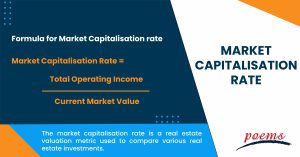Market capitalisation rate
Table of Contents
Market capitalisation rate
The market capitalisation rate is the total dollar market value of outstanding shares of stock of a company. Instead of sales or total assets, the investment community uses this metric to assess a company’s size. The market cap is used to analyze whether a takeover candidate delivers value to the acquirer.
In commercial real estate, the projected rate of return on an investment property is referred to as the market capitalisation rate. This metric is calculated based on the property’s expected net income and is expressed as a percentage by dividing net operating income by property asset value. It calculates the possible return on an investor’s real estate investment.
What is market capitalisation rate?
The market capitalisation rate is a real estate valuation metric used to compare various real estate investments. Even though there are numerous variants, the cap rate is often calculated as the division of the annual rental income of a real estate asset by its current market value.
The definition of annual rental income determines the majority of variations and whether it is gross or net of annual costs, as well as whether the annual rental income is the actual amount received (initial yields) or the potential rental income that could be received if the asset is optimally rented.
The market capitalisation rate is most useful for comparing the relative value of comparable real estate investments.
Understanding market capitalisation rate
The market capitalisation rate is the most commonly used metric for evaluating real estate investments’ profitability and return potential. The cap rate shows the return over one year if a property is bought in cash without a loan. The capitalisation rate represents the intrinsic, natural, and unlevered rate of return on the property.
The capitalisation rate is a profitability indicator used to calculate a real estate property’s return on investment. It is determined as net operating income divided by the asset’s current market value.
The capitalisation rate can be used to determine how risky an investment opportunity is; a high capitalisation rate denotes higher risk, while a low capitalisation rate denotes lower risk. However, the capitalisation rate should always be used following other metrics rather than as the sole criterion for an investor to purchase a property.
How to calculate the market capitalisation rate?

The market capitalisation rate of a real estate investment is determined using the most general formula by dividing the net operating income (NOI) by the property’s current market value.
Market Capitalisation Rate = Total Operating Income / Current Market Value.
After subtracting all expenses associated with property management, the (anticipated) annual revenue generated by the property (such as rents) is known as the net operating income.
Importance of market capitalisation rate
The market capitalisation rate is crucial because it allows potential investors to grasp the true value of firms, and the relative size of one company to another. It assists investors in predicting the future performance of a company’s stock since it indicates what the market is prepared to pay for the stock.
With a better understanding of the market capitalisations of various companies, investors can make more informed decisions about the types of stocks they want in their portfolios based on their investment goals. Large-cap, mid-cap, and small-cap stocks have the potential to lead the markets over time because they are affected differently by economic changes. As a result, investors prefer to have a diverse portfolio that includes a well-balanced mix of these three types of stocks.
Types of companies based on market capitalisation rate
People frequently categorize corporations based on their market capitalisation rates:
- Micro-cap
A company with a market capitalisation of less than $300 million.
- Small-cap
between $300 million and $2 billion.
- Mid-cap
between $2 billion and $10 billion.
- Large-cap
a market capitalisation of greater than $10 billion.
Some have also used mega-cap and nano-cap to refer to enterprises worth more than $200 billion and less than $50 million, respectively.
Frequently Asked Questions
A few factors which impact the market capitalisation rate are:
- The location of the property can have a significant impact on the capitalisation rates. The risk of the site is linked to the firms’ cap rate.
- A big competitive market with less risk may have lower capitalisation rates than a smaller market with higher risk.
- The property value’s long-term reliability may become the most crucial aspect.
- A property with a lot of potential in a booming market may see its capitalisation rate altered.
- The amount of money invested into the property greatly impacts the capitalisation rate since it directly affects the NOI.
The market capitalisation rate is a real estate valuation metric used to compare various real estate investments. Although there are several variants, the cap rate is commonly computed as the ratio of a real estate asset’s yearly rental revenue to its current market value.
An investment strategy is a plan developed to assist individual investors in achieving their financial and investment objectives. Personal circumstances such as age, capital, risk tolerance, and goals determine one’s investment strategy.
The market capitalisation of a security may fluctuate over time due to the number of outstanding shares. This is especially true in cryptocurrencies, where new tokens or coins are created or coined regularly.
As new offerings theoretically dilute the value of existing coins, tokens, or shares, a different market cap formula can be used to calculate the potential market cap if all authorized shares or tokens are issued while remaining worth the current trading price.
This is known as the diluted market cap, and the formula is,
Diluted market capitalisation = current share price x the total number of authorized shares
A high market capitalisation rate indicates that the firm has a larger market presence. Larger organizations may have less potential for development than start-ups, but they may be able to acquire finance at a lower cost, have a more constant source of income, and rely on brand awareness. Though not universal, companies with larger market capitalisations are generally less risky than those with smaller ones.
The market cap rate does not affect the stock price; rather, the market cap is derived by assessing the stock price and the number of shares issued.
Although a blue-chip stock may perform better due to increased organizational efficiency and market presence, having a larger market cap does not immediately affect stock prices.
The market cap rate significantly impacts stock prices because it indicates whether a company is worth investing in, which can ultimately drive stock prices up or down.
Related Terms
- Payment Date
- Treasury Stock Method
- Reverse stock splits
- Ticker
- Restricted strict unit
- Gordon growth model
- Stock quotes
- Shadow Stock
- Margin stock
- Dedicated Capital
- Whisper stock
- Voting Stock
- Deal Stock
- Microcap stock
- Capital Surplus
- Payment Date
- Treasury Stock Method
- Reverse stock splits
- Ticker
- Restricted strict unit
- Gordon growth model
- Stock quotes
- Shadow Stock
- Margin stock
- Dedicated Capital
- Whisper stock
- Voting Stock
- Deal Stock
- Microcap stock
- Capital Surplus
- Multi-bagger Stocks
- Shopped stock
- Secondary stocks
- Screen stocks
- Quarter stock
- Orphan stock
- One-decision stock
- Repurchase of stock
- Stock market crash
- Half stock
- Stock options
- Stock split
- Foreign exchange markets
- Stock Market
- FAANG stocks
- Unborrowable stock
- Joint-stock company
- Over-the-counter stocks
- Watered stock
- Zero-dividend preferred stock
- Bid price
- Authorised shares
- Auction markets
- Market capitalisation
- Arbitrage
- Garbatrage
- Autoregressive
- Stockholder
- Penny stock
- Noncyclical Stocks
- Hybrid Stocks
- Large Cap Stocks
- Mid Cap Stocks
- Common Stock
- Preferred Stock
- Small Cap Stocks
- Earnings Per Share (EPS)
- Diluted Earnings Per Share
- Dividend Yield
- Cyclical Stock
- Blue Chip Stocks
- Averaging Down
Most Popular Terms
Other Terms
- Physical ETF
- Initial Public Offering
- Buyback
- Secondary Sharing
- Bookrunner
- Notional amount
- Negative convexity
- Jumbo pools
- Inverse floater
- Forward Swap
- Underwriting risk
- Reinvestment risk
- Final Maturity Date
- Secondary Market
- Margin Requirement
- Mark-to-market
- Pledged Asset
- Yield Pickup
- Subordinated Debt
- Trailing Stops
- Stochastic Oscillator
- Bullet Bonds
- Basket Trade
- Contrarian Strategy
- Exchange Control
- Notional Value
- Relevant Cost
- Dow Theory
- Speculation
- Stub
- Trading Volume
- Going Long
- Pink sheet stocks
- Rand cost averaging
- Sustainable investment
- Stop-limit sell order
- Economic Bubble
- Ask Price
- Constant prepayment rate
- Covenants
- Stock symbol
- Companion tranche
- Synthetic replication
- Bourse
- Beneficiary
- Witching Hour
- Widow and Orphan stock
- Public Float
- Closing Price
- Quiet period
Know More about
Tools/Educational Resources
Markets Offered by POEMS
Read the Latest Market Journal

Weekly Updates 15/4/24 – 19/4/24
This weekly update is designed to help you stay informed and relate economic and company...

From $50 to $100: Unveiling the Impact of Inflation
In recent years, inflation has become a hot topic, evoking strong emotions as the cost...

Japan’s Economic Resurgence: Unveiling the Tailwinds Behind Nikkei 225’s Record Leap
Source: eSignal, Intercontinental Exchange, Inc. In the heart of Japan’s economic landscape, the Nikkei 225...

Weekly Updates 8/4/24 – 12/4/24
This weekly update is designed to help you stay informed and relate economic and...

What Makes Forex Trading Attractive?
In a world where the click of a button can send goods across oceans and...

Weekly Updates 1/4/24 – 5/4/24
This weekly update is designed to help you stay informed and relate economic and company...

How to soar higher with Positive Carry!
As US Fed interest rates are predicted to rise 6 times this year, it’s best...

Why 2024 Offers A Small Window of Opportunity and How to Position Yourself to Capture It
With the Federal Reserve (FED) finally indicating rate cuts in 2024, we witnessed a significant...


















